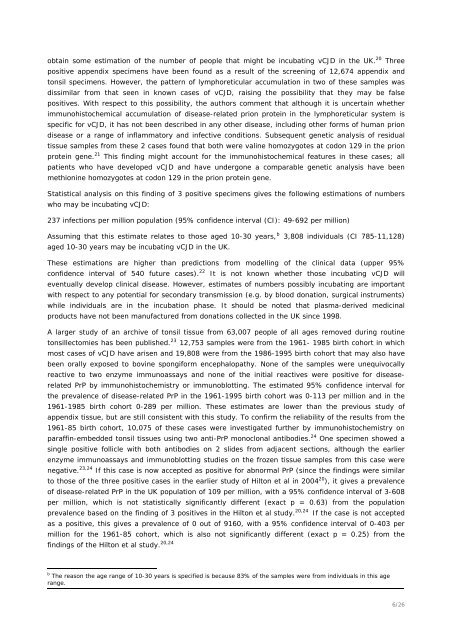CHMP position statement on Creutzfeldt-Jakob disease and plasma ...
CHMP position statement on Creutzfeldt-Jakob disease and plasma ...
CHMP position statement on Creutzfeldt-Jakob disease and plasma ...
Create successful ePaper yourself
Turn your PDF publications into a flip-book with our unique Google optimized e-Paper software.
obtain some estimati<strong>on</strong> of the number of people that might be incubating vCJD in the UK. 20 Three<br />
positive appendix specimens have been found as a result of the screening of 12,674 appendix <strong>and</strong><br />
t<strong>on</strong>sil specimens. However, the pattern of lymphoreticular accumulati<strong>on</strong> in two of these samples was<br />
dissimilar from that seen in known cases of vCJD, raising the possibility that they may be false<br />
positives. With respect to this possibility, the authors comment that although it is uncertain whether<br />
immunohistochemical accumulati<strong>on</strong> of <strong>disease</strong>-related pri<strong>on</strong> protein in the lymphoreticular system is<br />
specific for vCJD, it has not been described in any other <strong>disease</strong>, including other forms of human pri<strong>on</strong><br />
<strong>disease</strong> or a range of inflammatory <strong>and</strong> infective c<strong>on</strong>diti<strong>on</strong>s. Subsequent genetic analysis of residual<br />
tissue samples from these 2 cases found that both were valine homozygotes at cod<strong>on</strong> 129 in the pri<strong>on</strong><br />
protein gene. 21 This finding might account for the immunohistochemical features in these cases; all<br />
patients who have developed vCJD <strong>and</strong> have underg<strong>on</strong>e a comparable genetic analysis have been<br />
methi<strong>on</strong>ine homozygotes at cod<strong>on</strong> 129 in the pri<strong>on</strong> protein gene.<br />
Statistical analysis <strong>on</strong> this finding of 3 positive specimens gives the following estimati<strong>on</strong>s of numbers<br />
who may be incubating vCJD:<br />
237 infecti<strong>on</strong>s per milli<strong>on</strong> populati<strong>on</strong> (95% c<strong>on</strong>fidence interval (CI): 49-692 per milli<strong>on</strong>)<br />
Assuming that this estimate relates to those aged 10-30 years, b 3,808 individuals (CI 785-11,128)<br />
aged 10-30 years may be incubating vCJD in the UK.<br />
These estimati<strong>on</strong>s are higher than predicti<strong>on</strong>s from modelling of the clinical data (upper 95%<br />
c<strong>on</strong>fidence interval of 540 future cases). 22 It is not known whether those incubating vCJD will<br />
eventually develop clinical <strong>disease</strong>. However, estimates of numbers possibly incubating are important<br />
with respect to any potential for sec<strong>on</strong>dary transmissi<strong>on</strong> (e.g. by blood d<strong>on</strong>ati<strong>on</strong>, surgical instruments)<br />
while individuals are in the incubati<strong>on</strong> phase. It should be noted that <strong>plasma</strong>-derived medicinal<br />
products have not been manufactured from d<strong>on</strong>ati<strong>on</strong>s collected in the UK since 1998.<br />
A larger study of an archive of t<strong>on</strong>sil tissue from 63,007 people of all ages removed during routine<br />
t<strong>on</strong>sillectomies has been published. 23 12,753 samples were from the 1961- 1985 birth cohort in which<br />
most cases of vCJD have arisen <strong>and</strong> 19,808 were from the 1986-1995 birth cohort that may also have<br />
been orally exposed to bovine sp<strong>on</strong>giform encephalopathy. N<strong>on</strong>e of the samples were unequivocally<br />
reactive to two enzyme immunoassays <strong>and</strong> n<strong>on</strong>e of the initial reactives were positive for <strong>disease</strong>related<br />
PrP by immunohistochemistry or immunoblotting. The estimated 95% c<strong>on</strong>fidence interval for<br />
the prevalence of <strong>disease</strong>-related PrP in the 1961-1995 birth cohort was 0-113 per milli<strong>on</strong> <strong>and</strong> in the<br />
1961-1985 birth cohort 0-289 per milli<strong>on</strong>. These estimates are lower than the previous study of<br />
appendix tissue, but are still c<strong>on</strong>sistent with this study. To c<strong>on</strong>firm the reliability of the results from the<br />
1961-85 birth cohort, 10,075 of these cases were investigated further by immunohistochemistry <strong>on</strong><br />
paraffin-embedded t<strong>on</strong>sil tissues using two anti-PrP m<strong>on</strong>ocl<strong>on</strong>al antibodies. 24 One specimen showed a<br />
single positive follicle with both antibodies <strong>on</strong> 2 slides from adjacent secti<strong>on</strong>s, although the earlier<br />
enzyme immunoassays <strong>and</strong> immunoblotting studies <strong>on</strong> the frozen tissue samples from this case were<br />
negative. 23,24 If this case is now accepted as positive for abnormal PrP (since the findings were similar<br />
to those of the three positive cases in the earlier study of Hilt<strong>on</strong> et al in 2004 20 ), it gives a prevalence<br />
of <strong>disease</strong>-related PrP in the UK populati<strong>on</strong> of 109 per milli<strong>on</strong>, with a 95% c<strong>on</strong>fidence interval of 3-608<br />
per milli<strong>on</strong>, which is not statistically significantly different (exact p = 0.63) from the populati<strong>on</strong><br />
prevalence based <strong>on</strong> the finding of 3 positives in the Hilt<strong>on</strong> et al study. 20,24 If the case is not accepted<br />
as a positive, this gives a prevalence of 0 out of 9160, with a 95% c<strong>on</strong>fidence interval of 0-403 per<br />
milli<strong>on</strong> for the 1961-85 cohort, which is also not significantly different (exact p = 0.25) from the<br />
findings of the Hilt<strong>on</strong> et al study. 20,24<br />
b<br />
The reas<strong>on</strong> the age range of 10-30 years is specified is because 83% of the samples were from individuals in this age<br />
range.<br />
6/26


